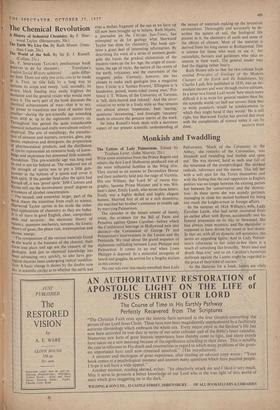The Chemical Revolution
(Collins, 25s.) t a
SHERWOOD TAYLOR'S posthumous book
deserves to do for chemistry • • Trevelyan's
Liittlish Social History achieved 3 quite differ- ent field. There are only two critkisms to be made Of it. First, its title fails by a long way to indicate its scope and sweep. And, secondly, its severe, black binding may easily frighten the humanist and the general reader who would most enjoy it. The early part of the book discusses the chemical achievements of man—that is to say, hIS power to transform one kind of matter into another—during the pre-scientific age extending from 4000 ac up to the eighteenth century AD. Throughout this period the quite considerable chemical industries and crafts were almost entirely empirical. The arts of metallurgy, the manufac- ture of cements and mortars, ceramics, glass, pig- ments, explosives and detergents, the preparation of pharmaceutical products, and the distillation of spirits represented an extensive body of know- edge and experience but possessed little scientific foundation. This pre-scientific age was long and its end is not far behind us. The medimval test of the strength of spirits was to put a little gun- Powder in the bottom of a spoon and cover it With spirit. If the powder fired after the spirit had burned off, it was 'proof spirit.' HM Customs and Excise still use the inconvenient 'proof' degrees as a nleasure of alcohol concentration.
The second, and somewhat larger, part of the book traces the transition from craft to science. Sherwood Taylor carries in his stride the indus- trial applications of chemistry as they are today. It is all there in good English, clear, comprehen- sible and accurate : the electronic theory of valency, quantum mechanics, isotopes, the kinetic theory of gases, the phase rule, transmutation and atomic energy.
The composition of the various materials found Ill the world is the business of the chemist, their form and place and age are the concern of the geologist. And just as chemical knowledge has been advancing very quickly, so also have geo- logical theories been undergoing radical modifica- tion. A basic change is shown by the doubts now felt in scientific circles as to whether the earth was
ever a molten fragment of the sun as we have up till now been brought up to believe. Ruth Moore, a journalist on the Chicago Sun-Times, has attempted to do for geology what Sherwood Taylor has done for chemistry. Her book con- tains a great deal of interesting information. By describing the work of a series of eminent geolo- gists she traces the gradual elaboration of the modern views on the Ice Age, the origin of moun- tains, the age of rocks, the nature of the centre of the earth, volcanoes, and the movement of the magnetic poles. Unwisely, however, she has chosen to make each geologist into a magazine hero. Cuvier is a 'human Everest,' Ellington is 'a handsome, poised, many-sided young man,' Pro- fessor J. T. Wilson, of the University of Toronto, is 'tall, dark-haired and relaxed.' And the deter- mination to write -in a lively style so that streams are almost always 'impetuous,' heat 'searing,' questions 'devastating,' and foresight 'uncanny' tends to obscure the genuine merits of the work.
Sir John Russell's book deals with a narrower aspect of our present scientific understanding of the nature of materials making up the terrestrial environment. Thoroughly and accurately he de- scribes the nature of soil, the biological life present in it, the chemistry of earth and some of the effects of climate. Most of the material is derived from his long career at Rothamsted. This is science for those who want to use it : for naturalists, farmers and gardeners who take an interest in their work. The general reader may find the digging rather heavy.
Ruth Moore tells us that the two-volume book entitled Principles of Geology or the Modern Changes of the Earth and Its Inhabitants, by Charles Lyell, first published in 1830, was an im- mediate success and went through twelve editions. In a letter to a friend Lyell wrote 'how much more difficult it is to write for general readers than for the scientific world, yet-half our savants think that to write popularly would be condescension to which they might bend if they would.' He is still right, but Sherwood Taylor has proved that even with the complexities of science today it can be


































 Previous page
Previous page